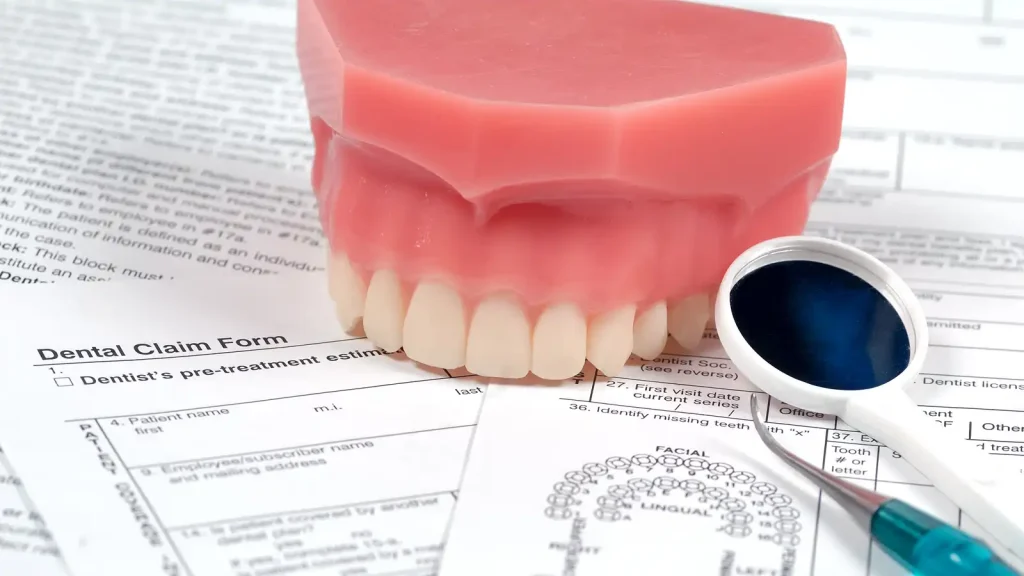Ever wondered how some people manage to get those pearly whites with dental implants, but couldn’t understand how they afforded them? We feel you. But is it possible to get dental implants covered by insurance?
Dental implants can cost over five thousand dollars per tooth, which puts them out of reach for many people. But there’s a hidden fact that not everyone is aware of – it’s possible to get dental implants covered by insurance. Yes, that’s correct!
Although it may be challenging, with some persistence and expertise, you can achieve at least partial coverage. In this article, we’ll walk you through everything you need to know to get your dental insurance to foot part of the bill for implants.
You will learn how to know if you have coverage, improve the likelihood of getting coverage by making strategic choices in timing and providers, and challenge any rejections. We will ensure that you have all the necessary tools to achieve the bright, confident smile you deserve, without exceeding your budget.
Understanding Dental Insurance Coverage for Implants
Understanding what your dental insurance plan covers for implants can be complicated because policies vary. It’s important to know what your plan includes to manage costs and expectations effectively.
Check Your Policy Details
First, carefully examine your dental insurance policy to find out if it covers dental implants, either partially or entirely. Unfortunately, the majority of typical policies do not include coverage for implants since insurance companies view them as cosmetic procedures.
But, a few might offset a part of the overall expenses. Get in touch with your insurance company for details about your coverage
Ask About Additional Coverage
If your current policy does not cover implants, consider buying extra coverage or a dental implant rider to assist with the expenses.
Even though additional insurance premiums cost more, they could ultimately be more cost-effective than paying for implants without insurance in the future. Some insurance companies offer these supplemental plans on a voluntary basis.
Discuss Costs With Your Dentist
Even if you have coverage, implants are expensive, ranging from $1,000 to $3,000 per implant. Meet with your dentist to develop a comprehensive treatment plan so you know the total costs before proceeding.
Your dentist may be willing to work with you on a payment plan to make implants more affordable. They can also provide information to submit to your insurance company to appeal for higher coverage due to medical necessity.
Consider Alternatives If Implants Are Not Possible
Unfortunately, implants are not an option for everyone due to health or financial issues. Discuss alternative treatments with your dentist like dentures, bridges, or partial dentures.
They may not be ideal, but these options can still allow you to eat, speak, and smile confidently until you are in a position to get dental implants.
Implants provide permanent tooth replacement solutions, but insurance coverage and costs are the challenges to tackle. Following these steps can help determine your options and make implants possible if desired and medically appropriate for your situation.
What to Look for in a Dental Insurance Plan That Covers Implants
Choosing a dental insurance plan that covers implants can be tough. The good news is, that some major insurance companies do offer coverage for implants, you just have to know what to look for.
First, check if implants are included in the plan and to what extent. The best plans will cover implants at 50-80% of the total cost.
Delta Dental’s Individual PPO Premium Plan pays for implants at 60-80% based on the dentist a patient selects. While some insurance providers such as Aetna and Cigna have plans that cover implants, not all do so confirm beforehand
Second, examine the annual maximum. For implants, a higher annual maximum, such as $2,000-$5,000 per individual, is preferable. This will assist in covering part of the cost of the procedure that you need to undergo. Also, identify whether implants are categorized as the annual maximum allowance for preventive services or as major restorative services.
Check which dentists in your area take the insurance and their experience with dental implants. It is recommended that you go to a qualified dentist with advanced training and experience in the field. Find out if they are an “in-network” dentist for maximum benefits.
Finally, ask if there are any waiting periods for implants and plan requirements. Some plans may make you use your insurance for 6-12 months before they allow implants or they may require regular cleaning and check-up sessions. Be prepared to pay higher premiums if there are long waiting periods or strict rules for the chosen plan.
The average cost of a single dental implant is $1,000-$3,000, so it is important to select an insurance plan that will cover the implants to the maximum extent possible to save money and make this life-changing dental procedure affordable.
Take your time and compare plans to find one that suits both your needs and your budget.

Alternatives to Dental Implants
Dental implants aren’t for everyone. They can be expensive, invasive, and time-consuming. Luckily, there are several other options for replacing missing teeth that may better suit your needs and budget.
Dental Bridges
Dental bridges are fake teeth bonded to your natural teeth on either side of the gap. The most common types are traditional bridges and resin-bonded bridges.
Standard bridges require grinding down healthy teeth to support the bridge, while resin-bonded bridges have a lower impact on natural teeth.
Bridges usually last 5 to 15 years and cost less than implants. They may not feel as natural as implants and need the support of adjacent teeth.
Dentures
Dentures are removable devices with artificial teeth that you can take out and put back in yourself. Partial dentures replace some missing teeth, while complete dentures replace all teeth in an upper or lower jaw.
Dentures are very affordable but may feel bulky or loose in your mouth. They also require removing and cleaning daily and need to be replaced every 5 to 10 years as your gums and bones change shape with time.
Flippers
A flipper is a temporary partial denture you can remove yourself to fill in gaps from one or more missing teeth. It’s made of acrylic resin and fits over your gums and any remaining teeth.
Flippers are a quick, inexpensive short-term solution while you consider more permanent options. However, they may feel unnatural and insecure in your mouth since they’re removable. Flippers normally last 6 months to 2 years before needing replacement.
Other alternatives like dental implants supported bridges and resin-bonded bridges offer more stability than dentures or flippers but at a lower cost than traditional dental implants.
Discussing the pros and cons of each option with your dentist can help choose the best and most affordable solution based on your needs.
How Much Do Dental Implants Cost With Insurance?
Just like the removal of wisdom tooth — Dental implants can be expensive, often $1,000 to $3,000 per implant. The good news is, dental insurance may help reduce your out-of-pocket costs. Most dental insurance plans cover implants at 50% to 80% of the total cost.
Check Your Dental Insurance Plan
The first step is to check with your insurance provider to see if implants are covered under your plan and how much is covered.
Some plans cover implants fully, while most cover a portion of the initial procedure and follow-up care. The industry average is 50-80% coverage.
Plans with higher monthly premiums, like $50-70 per month, typically offer better coverage.
Compare Plan Options
If your current plan does not cover implants or you’re shopping for new dental insurance, compare plans that offer implant coverage.
Look at factors like deductibles, copays, coverage limits, and out-of-pocket maximums. Plans with lower deductibles and higher annual coverage limits will likely cover more of your implant costs.
Use a Dentist In Your Network
Seeing an in-network dentist is key to getting the most insurance coverage for your implants. In-network dentists have agreed to accept lower, negotiated rates from your insurance company.
Out-of-network dentists are free to charge their rates and your insurance may pay less, leaving you with higher out-of-pocket costs.
Ask About Bundling and Discounts
Some dentists offer discounts if you get multiple implants or bundle other procedures, like a dental bridge, with your implants. They may also provide payment plans to make the procedure more affordable. Be sure to ask if any discounts or payment options are available.
While insurance can help significantly reduce the cost of dental implants, you will likely still have a portion of the fees to pay out of pocket. But with some research into your insurance options and talking to your dentist about ways to lower costs, dental implants can be within your financial reach.
How to Get Dental Implants Covered By Insurance
Most dental insurance plans will not cover the full cost of dental implants because they are considered cosmetic procedures. However, there are a few ways you can get at least partial coverage for implants.
First, check if implants are covered under any circumstances by your insurance plan. Some plans may cover implants needed to replace teeth lost in an accident, injury, or dental disease.
Call your insurance company and ask if they cover implants and what percentage of the costs they cover. It could be anywhere from 25% to 50% which can still help offset some of the expense.
Next, ask your dentist if the implants are medically necessary in your case. If implants are needed to correct a medical issue like a cleft palate or other jaw deformity, insurance is more likely to provide coverage. Your dentist can submit a request to your insurance plan explaining why implants are medically necessary in your specific situation.
It would be best if you also looked into insurance plans that include dental implants covered by insurance. Some private dental insurance plans do offer coverage for implants, especially if purchased as part of a group plan through your employer.
If changing insurance plans is an option, compare plans that include coverage for major dental procedures like implants, crowns, and dentures. The premiums may be higher but could still save you money in the long run.
Finally, ask your dentist if a less expensive temporary solution like a bridge or partial denture could work for now. If the temporary option fails or does not work well for you, your insurance may then cover part of the cost of implants as a last resort.
It’s not ideal, but a temporary solution could at least buy you some time to save money for implants or switch to an insurance plan with better coverage.
With some research, you can increase your chances of getting dental implants covered by insurance. Don’t get discouraged — keep calling, get the necessary approvals from your dentist, and explore all options to reduce your out-of-pocket costs.
Getting insurance to cover dental implants can be challenging, but with careful preparation and persistence, you can succeed. Check your policy, get cost estimates, and submit the necessary paperwork.
Be ready to appeal if you get denied at first. Bring in your dentist as an ally. And don’t give up if an insurance company gives you the runaround – keep politely advocating for yourself. With strategic planning and patience, you can get at least partial coverage for those pricey implants. Now go give that insurance company a run for their money!







